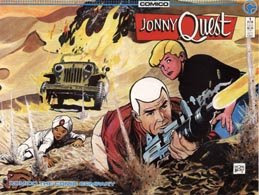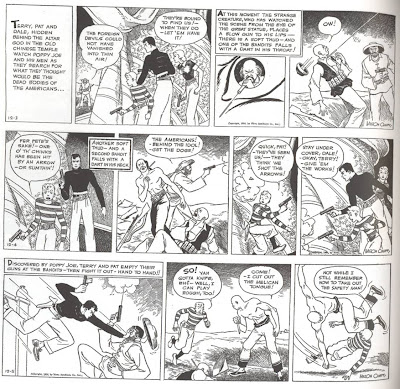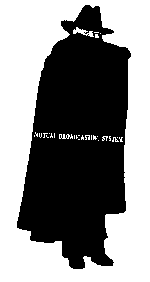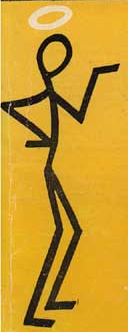
JONNY QUEST:
Actually, it’s not just Jonny whom I would like to move into the real world, but his entire extended family. That includes his dad, brilliant scientist Benton Quest; his best friend Hadji; and the family bodyguard Roger “Race” Bannon.
The original 1964-65 animated adventure series is a true classic. Like all Hanna-Barbara TV entries, it used somewhat limited animation. But great characters designs (by artist Doug Wildey) and nifty locations, vehicles and scientific devices were all combined with solid storytelling. The results were 26 half-hour episodes that still entertain over 4 decades later.
Images from several episodes are, in fact, practically iconic. The giant mechanical spider-thing in “The Robot Spy,” for instance, is a magnificent visual. The sequence in “Turu the Terrible,” in which Dr. Quest and Race don jet packs and grab a bazooka in order to hunt down a pteranadon, is easily one of the coolest things ever.
Actually, it’s not just Jonny whom I would like to move into the real world, but his entire extended family. That includes his dad, brilliant scientist Benton Quest; his best friend Hadji; and the family bodyguard Roger “Race” Bannon.
The original 1964-65 animated adventure series is a true classic. Like all Hanna-Barbara TV entries, it used somewhat limited animation. But great characters designs (by artist Doug Wildey) and nifty locations, vehicles and scientific devices were all combined with solid storytelling. The results were 26 half-hour episodes that still entertain over 4 decades later.
Images from several episodes are, in fact, practically iconic. The giant mechanical spider-thing in “The Robot Spy,” for instance, is a magnificent visual. The sequence in “Turu the Terrible,” in which Dr. Quest and Race don jet packs and grab a bazooka in order to hunt down a pteranadon, is easily one of the coolest things ever.

-
-
-
-
-
-
-
-
-
-
-
-
-
-
-
-
-
-
--
-
-
-
-
-
-
Dr. Quest, in fact, was the go-to guy for just about any sort of strange situation. Whether the problem was ships being mysteriously destroyed at sea, recovering an experimental missile from its crash point in the Arctic, or dealing with an apparent werewolf in the Canadian woods, Dr. Q was your man.
Race and the two kids would inevitably tag along and end up playing a key role in the adventure. Race handled the heaviest of the strong arm stuff—though both Dr. Quest and the boys were no slouches in that area. (Watching Jonny and Hadji judo-throw thugs was always fun.)
Jonny was the sort of kid we all (as kids) wished we could be. His life consisted of travel to exotic places, highlighted by one adventure after another. If he had to tolerate the occasional assassin sticking a tarantula in his bed while he slept—well, that seemed to be a more-than-fair trade-off.
TERRY LEE (from Terry and the Pirates):
One of the admitted influences for Jonny Quest, Milt Caniff’s newspaper strip Terry and the Pirates is arguable the finest adventure strip ever.
When it began in 1934, Terry Lee and his guardian Pat Ryan arrive in China, looking for an old mine left to Terry by his grandfather. The ensuing adventure, involving a bandit base secreted in the tunnels of the mine, was slam-bang exciting right from the start.
Caniff proved to be a masterful storyteller. As the strip progressed, his art became more refined and realistic. The characterizations were wonderful, while the storylines always enthralling and often complex. Terry was maybe twelve-years-old when the strip premiered and, like Jonny Quest, he had one heck of a childhood. He encountered pirates, bandits, invading Japanese soldiers, murderers and con artists. Villains came at him with fists, knives and guns, but he took it all in stride. Like Jonny, he was wish-fulfillment personified.
Race and the two kids would inevitably tag along and end up playing a key role in the adventure. Race handled the heaviest of the strong arm stuff—though both Dr. Quest and the boys were no slouches in that area. (Watching Jonny and Hadji judo-throw thugs was always fun.)
Jonny was the sort of kid we all (as kids) wished we could be. His life consisted of travel to exotic places, highlighted by one adventure after another. If he had to tolerate the occasional assassin sticking a tarantula in his bed while he slept—well, that seemed to be a more-than-fair trade-off.
TERRY LEE (from Terry and the Pirates):
One of the admitted influences for Jonny Quest, Milt Caniff’s newspaper strip Terry and the Pirates is arguable the finest adventure strip ever.
When it began in 1934, Terry Lee and his guardian Pat Ryan arrive in China, looking for an old mine left to Terry by his grandfather. The ensuing adventure, involving a bandit base secreted in the tunnels of the mine, was slam-bang exciting right from the start.
Caniff proved to be a masterful storyteller. As the strip progressed, his art became more refined and realistic. The characterizations were wonderful, while the storylines always enthralling and often complex. Terry was maybe twelve-years-old when the strip premiered and, like Jonny Quest, he had one heck of a childhood. He encountered pirates, bandits, invading Japanese soldiers, murderers and con artists. Villains came at him with fists, knives and guns, but he took it all in stride. Like Jonny, he was wish-fulfillment personified.

He also met the absolutely best-lookin’ gals ever to grace a comics page. The Dragon Lady, Burma, April Kane, Raven Sherman—just to name a few. Caniff had a real talent for drawing a pretty lady.
Terry aged normally as the strip progressed and was old enough to serve as a fighter pilot during World War II. By the time Caniff left the strip in 1946, Terry was flying a cargo plane around China while working undercover for Military Intelligence.
But whether man or boy, Terry Lee was one heck of a guy. Neither he nor Jonny Quest are real—but, by golly, they should be.









 BATMAN
Writer Bill Finger and artist Bob Kane never denied that their most famous creation—the Batman—was heavily influenced by the Shadow. But a recent reprint of the 1936 Shadow novel Partners in Peril reveals just how much of an influence the Shadow was.
Bill Finger actually lifted the plot from Partners in Peril wholesale for the first Batman story (which appeared in Detective Comics #27 in 1939). But, of course, the two characters are very similar. Both are wealthy men who take on scary identities in order to battle bad guys. They share the same ambience; the same type of urban setting; the same tendency to run across bizarre super-criminals.
But there are differences. The Shadow leaves a trail of dead thugs behind him wherever he goes, while Batman (after some early stories in which he did use lethal force) always took villains alive if possible, disdaining the use of firearms. The addition of Robin, the Boy Wonder, also distanced Batman from the Shadow. (It’s difficult to imagine the Shadow with a "Shadow Jr." tagging along after him.) Robin was the proto-typical young sidekick, added to the Batman mythos because the readers of comic books were on average younger than the readers of pulps.
But whatever his similarities or differences with the Shadow, the Batman soon became equally cool. Finger and other writers produced some of the best-constructed and strongest comic book scripts of that era. Kane’s unique art complemented the stories perfectly. Bizarre and visually striking villains (most notably the Joker) soon gave Batman one of the best personal Rogue’s Galleries ever.
Both the Shadow and the Batman are still around today. A series of reprints of the original Shadow pulps are currently coming out on a monthly basis. Batman's comic book run--despite some creatively weak periods--is still going strong after nearly 70 years. Both characters seem likely to stay around for some time to come.
The Shadow and Batman—They aren’t real, but by golly, they oughta be.
BATMAN
Writer Bill Finger and artist Bob Kane never denied that their most famous creation—the Batman—was heavily influenced by the Shadow. But a recent reprint of the 1936 Shadow novel Partners in Peril reveals just how much of an influence the Shadow was.
Bill Finger actually lifted the plot from Partners in Peril wholesale for the first Batman story (which appeared in Detective Comics #27 in 1939). But, of course, the two characters are very similar. Both are wealthy men who take on scary identities in order to battle bad guys. They share the same ambience; the same type of urban setting; the same tendency to run across bizarre super-criminals.
But there are differences. The Shadow leaves a trail of dead thugs behind him wherever he goes, while Batman (after some early stories in which he did use lethal force) always took villains alive if possible, disdaining the use of firearms. The addition of Robin, the Boy Wonder, also distanced Batman from the Shadow. (It’s difficult to imagine the Shadow with a "Shadow Jr." tagging along after him.) Robin was the proto-typical young sidekick, added to the Batman mythos because the readers of comic books were on average younger than the readers of pulps.
But whatever his similarities or differences with the Shadow, the Batman soon became equally cool. Finger and other writers produced some of the best-constructed and strongest comic book scripts of that era. Kane’s unique art complemented the stories perfectly. Bizarre and visually striking villains (most notably the Joker) soon gave Batman one of the best personal Rogue’s Galleries ever.
Both the Shadow and the Batman are still around today. A series of reprints of the original Shadow pulps are currently coming out on a monthly basis. Batman's comic book run--despite some creatively weak periods--is still going strong after nearly 70 years. Both characters seem likely to stay around for some time to come.
The Shadow and Batman—They aren’t real, but by golly, they oughta be.





